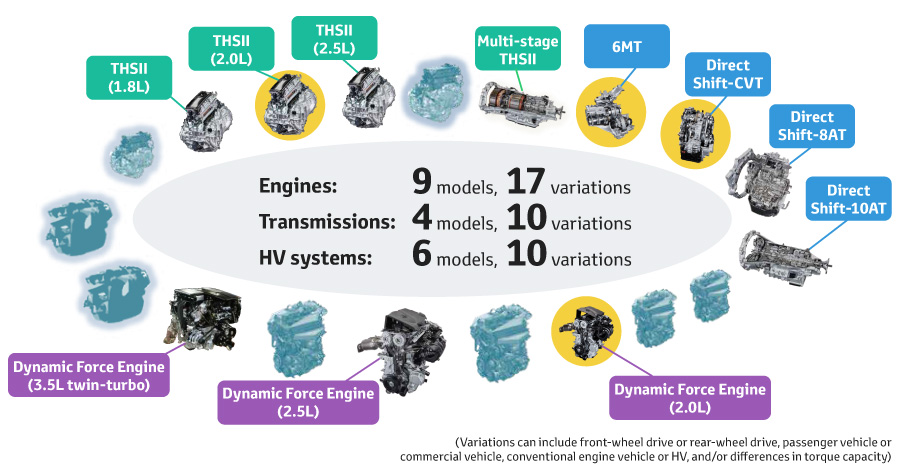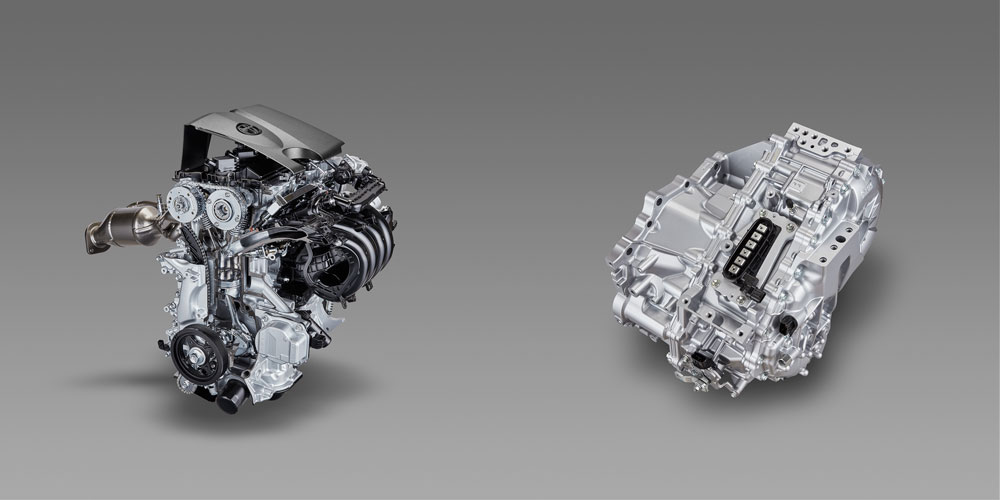Thanks for starting this topic ssun30.
So a few things to keep in mind:
- there won't be any updated previous-gen gas engines making the master TNGA diagram Toyota has shown. TNGA engines are all new engines. So whatever engines with displacement of less than 2.0L that will debut, will be all new. The exceptions here being the THS-II 1.8L and the multi-stage THS-II systems, which both use non-TNGA gas engines. However the good thing is that engines can easily be replaced/updated on Toyota's THS systems. I fully expect the multi-stage THS-II to get the V35A engine soon, along with the 1.8L THS-II either getting a Dynamic Force gas engine, or being replaced in usage by the 2.0L THS-II Dynamic Force system.
- the new torque vectoring AWD system is not some "eLSD" system or whatever else people may be thinking of. This is not some "open diff" rehashed system. This would be like saying Toyota's KDSS is some "e" system. This new torque vectoring AWD sysytem has two physical clutches on both the front and rear shafts, which are part of a disconnect mechanism. Toyota otherwise was very vague on details so far. It may have a mechanical lock ability. It is also paired to a new mysterious AWD Integrated Management system, which Toyota also did not detail. This likely hints at some sort of terrain management features. Also in the demonstration video, based on the Rav4 rims, the 'current model' is almost certainly a Rav4, while the 'new model' isn't really important, as it could be a number of vehicles. What's important is the capability of the system. The new E-Four 4WD system is indeed what some of you are thinking of, in that it is an "eLSD open-diff" type system, as the E-Four system does not have physical clutches and physical linkages.
- I feel a significant achievement that needs more emphasis is the overall fuel economy numbers (along with the power numbers) that Toyota is touting here. In real world driving, Toyota's 1.8L current THS-II in the 4th gen Prius is arguably the most efficient hybrid system in real-world driving. Toyota claims this new TNGA 2.0L THS-II system achieves 9% more fuel efficiency than the 1.8L THS-II. That is very impressive, considering this new 2.0L THS-II offers much more power than the 1.8L THS-II. Arguably, the 1.8L THS-II system shouldn't even be on Toyota's TNGA diagram, because it still uses the previous-gen 2ZR engine, which is not a TNGA engine.
Furthermore, the new 2.0L Dynamic Force gas engine (A20A-FKS?) with Direct Shift CVT achieves 18% improved fuel economy over the 2ZR-FE with CVT. The 2ZR-FE is already among the class leaders in fuel economy, and this Dynamic Force 2.0L is a HUGE step up in from the 2ZR. All this while achieving very impressive power figures. It achieves better power and torque figures than Honda's 2.0L naturally aspirated engine, while achieving better fuel economy. Furthermore, it achieves comparable HP to Honda's 1.5L turbocharged engine in regular Civic trim, while also achieving better fuel economy. This is impressive as turbo engines often achieve overrated government fuel economy figures, and tend to under-perform in real world fuel economy. In Civic Si trim, Honda's 1.5L turbo gets much better power numbers, but at the expense of greatly reduced fuel economy. This new Dynamic Force engine achieves better power and fuel economy than Ford's 2.0L 4 cylinder naturally aspirated engine. It even achieves better power and fuel economy than Mazda's praised 2.0L Skyactive-G engine. The Camry with the 2.5L A25A-FKS already achieves 2.0L/1.8L compact car fuel economy while being a 2.5L engine with plenty of power in a midsize sedan. The 1.5L turbo Accord achieves similar power and fuel economy levels, but the Accord 1.5L must resort to a CVT in order to do this, while the Camry has an 8-speed with the A25A-FKS. Also these are EPA numbers, and it's very possible the Camry beats the Accord 1.5L in real world fuel economy.
We can take the current Corolla as an example. In XLE trim, the Corolla with the 2ZR-FE and CVT gets 28/36 EPA mileage. If we apply Toyota's 18% fuel economy improvement that the new 2.0L Dynamic Force gets with Direct Shift CVT, we get about 33/42 or 33/43 EPA mileage. This would be class-leading, beating even the Civic sedan with the regular tune 1.5L turbo and CVT. It would beat the Civic's fuel economy while achieving comparable power figures. Also likely a better overall driving experience, as Toyota's new Direct Shift CVT is a superior design to Honda's CVT. Keep in mind these figures would simply be having the 2.0L Dynamic Force with Direct Shift CVT in the current Corolla. The coming next-gen Corolla may have better aerodynamics and other improvements, further helping fuel economy. These are near-hybrid fuel economy numbers when you think about it.
- I have a theory now that any TNGA engines with turbos might be limited mostly to Lexus models and select overseas Toyota models. Many of us have theorized that Toyota is jumping on the turbo bandwagon across the board, but so far there is little concrete evidence of this. Yes there is the 8AR-FTS, a non-TNGA design. It is featured in mostly Lexus models, and only a small select number of Toyota models in a few markets. Not on any Toyota models in North America. The V35A-FTS engine obviously is exclusive so far to the 5LS. So aside from Lexus, my theory is that any turbo TNGA engines will be offered only on a small select number of Toyota models in markets where engine displacement tax is very significant. Also given the disappointing real world performance of the 8AR-FTS, and even so far the mixed reactions the V35A-FTS is getting in the 5LS, Toyota may not be planning a significant turbo engine rollout. So I expect the rest of the TNGA engines yet to debut to be mostly naturally aspirated. Electric turbos would solve many of the current problems the 8AR-FTS and V35A-FTS have, but who knows if we will ever see electric turbos from Toyota at this point. So I theorize the TNGA workhorse replacement engines of the GR and UR will probably be naturally aspirated. When I say workhorse engines, I mean the base, core engines powering the majority of Toyota V6 and V8 models, along with some Lexus models. For example, the workhorse replacement of the GR series may be a V35A-FKS non-turbo engine. I could be wrong here, but I hope I'm not.
- On Toyota's 4WD master diagram, most of the 4WD and AWD systems are blanked-out, so they are yet to debut. I imagine then that we will be getting a number of new systems for Toyota's BOF vehicles, and possibly even a more hardcore specialized system for Toyota's top BOF off-roading vehicles. This is exciting to think about, as that 4WD master diagram holds a lot of mystery. This could be a long-shot, but just imagine if Toyota came out with a new hardcore 4WD system dedicated specifically to Toyota's TRD Pro lineup, or select Land Cruiser models? I'm sure that would keep the Jeep engineers up at night. Overall though that master 4WD diagram, along with the master powertrain diagram strongly hint at significant new TNGA technologies coming for Toyota's body-on-frame vehicles.
---
Overall I am happy to see more new TNGA engines debuting that are naturally aspirated. Also happy to see other exciting powertrain technologies debuting, from the new AWD systems, to the new CVT and manual transmissions, to the new hybrid system. As a long time Toyota fan, I'm beginning to feel some of the same excitement I had back in the mid 2000s when Toyota had a huge wave of new technologies, powertrains, and new and redesigned models that took the world markets by storm. Yes quality and durability did suffer somewhat as Toyota stretched itself too thin then, but it was fun to see Toyota dominating the competition so much.




